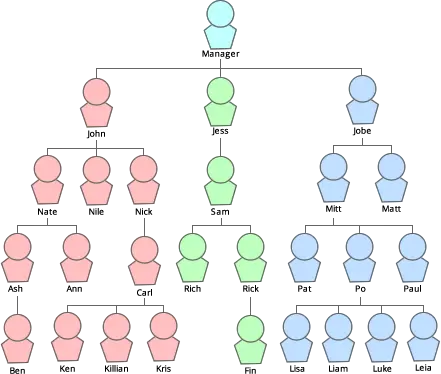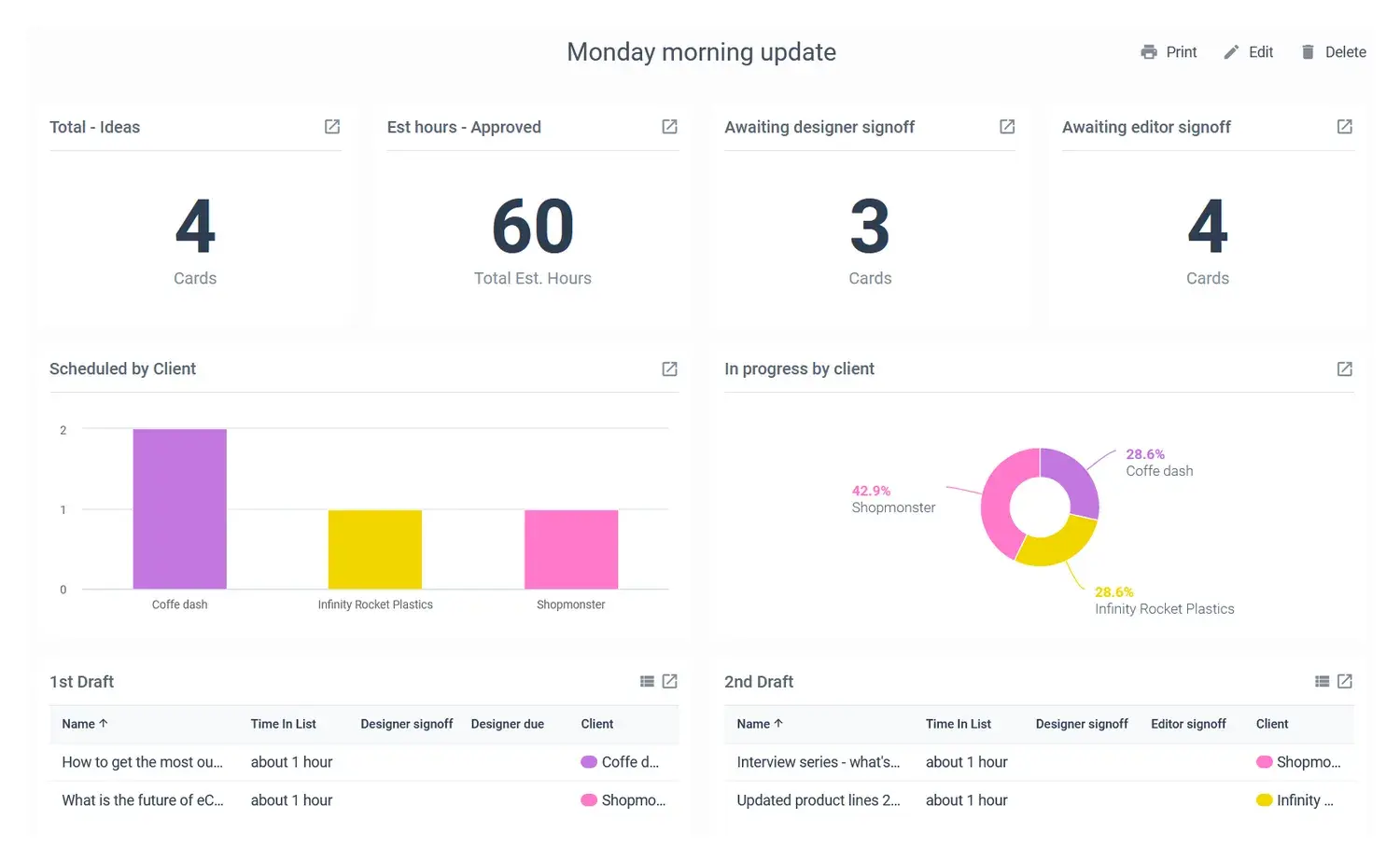Direct Reports
A direct report, also known as a subordinate, or staff member, is anyone who works for you in your company. To be successful, you need to be able to get along with your direct reports and ensure that they’re doing their jobs well so that you can do yours.
While you’ll likely have only one or two people reporting directly to you at first, it’s essential to learn how to manage them early on so that you don’t run into problems down the road when your company grows and you have many more employees reporting directly to you.
Whether you are a seasoned manager or you just got your first direct report, we will walk you through everything you need to know to manage your direct reports for maximum productivity and morale effectively. Blue Cat Reports offers various tools to help improve team productivity and create visibility for leaders like you.
What Are Direct Reports?
Direct reports are the people who report directly to you, which means they’re either in the same department as you or a different one that you oversee as part of your job. Simply put, direct reports are those that you manage. They’re your team members or subordinate staff.
Mid-level managers may have one or two direct reports, whereas senior leaders may have multiple direct reports that also have direct reports of their own. Here’s an example of a team hierarchy:

Sometimes, there can be some confusion about direct reports when you are a project manager or account manager responsible for determining a given team's workload. In this instance, while you may manage the team’s workloads and timelines, they may not necessarily report to you directly.
It depends on the organisational structure, but in many cases, technical positions such as engineers and designers will report to a technical manager, rather than a project manager. For instance, an engineer will often report to a senior engineer or an engineering manager.
A good way to tell whether or not you have a direct report is to ask yourself: am I giving this person their annual reviews? Am I the one who approves certain items for this person: e.g., holiday time or reimbursements? If this person was underperforming, would I be the one to deliver the feedback and put them on a performance plan? If the answers to these questions are no, the person may not report to you directly.
How to Get to Know a New Direct Report
If you just got promoted (congrats!) or are in the process of onboarding a new direct report to your team, you may not know quite where to start. Whenever someone new comes aboard your team, you must take the time to get to know the person personally and professionally.
Great leadership is all about people and relationships. No two contributors are the same, so you must get to know each individual and understand their workflow and management style so you can help set them up for success.
Especially when you’re new to management, having a direct report can be intimidating. However, once you learn how they work and what motivates them, it’s easy to build good working relationships with your direct reports. When approaching someone you’ve never managed before, here are some steps you can take to build rapport.
Conduct a One-on-One Intro Meeting
The first thing you should do when managing a direct report is to meet with them, introduce yourself, and get to know them. Start with some ice breakers and ask about their personal life, where they are from, and what they do for fun.
Outstanding leadership involves more than just getting down to business. Be genuinely interested in your team’s life outside of the office; this will strengthen your relationship with your employee and make them more comfortable when it comes to discussing things that pertain to work.
You should use this intro meeting to get to know their work style and what is important to them to be happy in their job. For instance, some people may value managerial support while others prioritise independence, trust, or autonomy. Then, depending on their preferences, you should be able to agree on an ongoing workflow that will work for both of you—for instance, weekly check-ins or daily stand-up meetings.
Some employees prefer to start their day early, and others are night owls. Some perform well while working in uninterrupted blocks; others need regular breaks to step away from their work. Understanding all of these intricacies will ultimately help you create a more successful relationship with your direct report and ensure that you’re setting them up for success and happiness.
This is also a great time to be transparent with the employee about your expectations and goals for the team. By conducting these one-on-one meetings, you’ll create some much-needed transparency and help make sure each employee is on the same page.
Work Alongside the Employee for a Day
When you get a new report, one of your first tasks should be to work alongside them to learn how they work. Ask them to explain their past projects, what they’re working on currently, and what they have lined up for upcoming work.
Then have a “working session” where you can both work through a problem and observe how they work. Pay attention to things they do that can be streamlined through automation or third-party tools, or simply use it as an opportunity to better understand how they tackle their list of items for the day. Especially if you are coming on to lead an existing team, this is an excellent way to learn more and ask questions.
There’s no better way to understand an employee’s style than by immersing yourself in it and seeing firsthand how they approach tasks and challenges.
How to Manage Direct Reports
Effectively managing direct reports means creating a culture of clear communication, effective task management, and consistent feedback. Here are some ways to make sure your direct reports feel like you’re on their side as a manager.
Running Effective Meetings
One of the most important things you can do to grow your business is to make sure you are scheduling and running effective meetings. The key here is not to schedule meetings just for the sake of having them but to be intentional when you take up the team’s time.
Too often, managers make the critical mistake of being overzealous with meetings. But your team’s time is valuable (and so is yours), so having meetings without a clear purpose or agenda can be inefficient and also frustrate your team.
It may take time to figure out what meeting cadence makes the most sense for your team, but the less frequently you can have them without obstructing progress, the better. This means having a clear schedule and agenda for each meeting and hopefully ending each with an action item or decision.
Delegating and Managing Work
One of the critical responsibilities of a leader is managing the work that their direct reports are doing. How you handle this largely boils down to each individual team member. Some employees may be able to work effectively toward a goal without much direction or hand-holding. Others will need their responsibilities or tasks clearly outlined for them.
If your direct reports are in technical roles, you may be able to defer to a project manager to manage their workflows while still providing oversight. In more general business roles, however, the way you manage and delegate work will again depend on the workflow of each individual.
When you have multiple people on your team, you will want to delegate work that complements each person’s strengths. In real terms, you can see how effective your direct reports are with completing tasks on time using a tool like Blue Cat Reports:

Over time, you can address issues and bottlenecks that hinder project velocity to create a stronger team that gets the job done. Regardless of the type of team you manage, using a project management and communication tool like Trello is a great way to keep track of progress and productivity.
Motivating and Inspiring Direct Reports
The next component of building an effective team is keeping your direct reports motivated and inspired by showing them how valuable they are to your company’s growth. When you lead by example, both your direct reports and their peers will take notice. It’s also crucial that you communicate your vision for how each team member can contribute to that vision and how your employees can make a difference in their respective roles.
Closing Thoughts
Knowing how to manage and lead a team can be a powerful tool in your career. A team will help propel you forward at work, but it can also bring challenges.
If you’re feeling like you need some guidance in leading a team, remember that even though leading and managing are different roles, they overlap quite a bit—which is why both skills should be used when managing others.
Leading is motivating; managing is directing and monitoring performance. You must be able to effectively do both to set yourself and direct reports up for success.
Check out Blue Cat Reports to see the tools and solutions we offer to help you manage teams and projects effectively.


